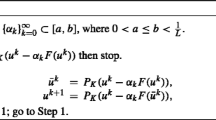Abstract
In this paper we introduce a new iterative scheme for the numerical solution of a class of linear variational inequalities. Each iteration of the method consists essentially only of a projection to a closed convex set and two matrix-vector multiplications. Both the method and the convergence proof are very simple.
Similar content being viewed by others
References
R.E. Bruck, “An iterative solution of a variational inequality for certain monotone operators in Hilbert space,”Bulletin of the American Mathematical Society 81 (1975) 890–892.
P.G. Ciarlet,Introduction to Matrix Numerical Analysis and Optimization, Collection of Applied Mathematics for the Master's Degree (Masson, Paris, 1982).
R.W. Cottle and G.B. Dantzig, “Complementary pivot theory of mathematical programming,”Linear Algebra and Its Applications 1 (1968) 103–125.
S. Dafermos, “An iterative scheme for variational inequalities,”Mathematical Programming 26 (1983) 40–47.
S.C. Fang, “An iterative method for generalized complementarity problems,”IEEE Transactions on Automatic Control AC 25 (1980) 1225–1227.
P.T. Harker and J.S. Pang, “A damped-Newton method for the linear complementarity problem,”Lectures in Applied Mathematics 26 (1990) 265–284.
B.S. He “A projection and contraction method for a class of linear complementarity problems and its application in convex quadratic programming,”Applied Mathematics and Optimization 25 (1992) 247–262.
M. Kojima, S. Mizuno and A. Yoshise, “A polynomial-time algorithm for a class of linear complementarity problems,”Mathematical Programming 44 (1989) 1–26.
C.E. Lemke, “Bimatrix equilibrium points and mathematical programming,”Management Science 11 (1965) 681–689.
C.E. Lemke and J.T. Howson, “Equilibrium points of bimatrix games,”SIAM Review 12 (1964) 45–78.
D.G. Luenberger,Introduction to Linear and Nonlinear Programming (Addison-Wesley, Reading, MA, 1973).
O.L. Mangasarian, “Solution of symmetric linear complementarity problems by iterative methods,”Journal of Optimization Theory and Applications 22 (1979) 465–485.
S. Mizuno, “A new polynomial time algorithm for a linear complementarity problems,”Mathematical Programming 56 (1992) 31–43.
J.S. Pang and D. Chan, “Iterative methods for variational and complementarity problems,”Mathematical Programming 24 (1982) 284–313.
J.S. Pang, “Variational inequality problems over productsets: applications and iterative methods,”Mathematical Programming 31 (1985) 206–219.
Author information
Authors and Affiliations
Additional information
This work is supported by the National Natural Science Foundation of the P.R. China and NSF of Jiangsu.
Rights and permissions
About this article
Cite this article
He, B. A new method for a class of linear variational inequalities. Mathematical Programming 66, 137–144 (1994). https://doi.org/10.1007/BF01581141
Received:
Revised:
Issue Date:
DOI: https://doi.org/10.1007/BF01581141




